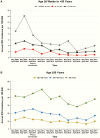Impact of the 13-Valent Pneumococcal Conjugate Vaccine on Invasive Pneumococcal Disease After Introduction Into Routine Pediatric Use
- PMID: 32415771
- PMCID: PMC7996647
- DOI: 10.1093/jpids/piaa035
Impact of the 13-Valent Pneumococcal Conjugate Vaccine on Invasive Pneumococcal Disease After Introduction Into Routine Pediatric Use
Abstract
Background: In 2010, the 13-valent pneumococcal conjugate vaccine (PCV13) replaced 7-valent PCV (PCV7) for protection against invasive pneumococcal disease (IPD). This study used laboratory surveillance data to examine the effect of PCV13 on IPD before and after PCV13 introduction among children aged 6 weeks to <6 years and those aged ≥6 weeks.
Methods: Observational laboratory-based IPD surveillance data were compared for the periods May 2010-April 2018 and May 2008-April 2010 (the PCV7 period) using a database of Kaiser Permanente Northern California (KPNC) members with laboratory-confirmed IPD.
Results: Among children aged 6 weeks to 6 years, overall IPD incidence decreased from 11.57 per 100 000 during the PCV7 period to 4.09 per 100 000 after PCV13 introduction; PCV13-type IPD incidence decreased from 5.12 to 0.84 per 100 000. Non-PCV13-serotype IPD did not change significantly in this age group (PCV7 period, 1.71 per 100 000 and after PCV13, 2.52 per 100 000). Of cases occurring in this group, bacteremia was the most common clinical diagnosis. Across all ages, IPD decreased from 9.49 to 6.23 per 100 000 and PCV13-type IPD decreased from 4.67 to 1.89 per 100 000, changes being mostly due to decreases in serotypes 19A and 7F. IPD caused by non-PCV13 serotypes did not change (3.34 and 3.35 per 100 000). Overall, pneumococci isolated after PCV13 introduction had increased susceptibility to penicillin, cefotaxime, and ceftriaxone.This prospective, laboratory-based surveillance study in Kaiser Permanente Northern California members examined annual IPD incidence before and after PCV13 introduction. In children aged 6 weeks to <6 years, IPD caused by PCV13 serotypes decreased significantly (84%) during the surveillance period.
Conclusions: IPD incidence decreased further in every age group after PCV13 introduction, suggesting both direct vaccination effects in the infant population and indirect effects in adults.
Clinical trials registration: NCT01128439.
Keywords: Streptococcus pneumoniae; all ages; PCV13; invasive pneumococcal disease.
© The Author(s) 2020. Published by Oxford University Press on behalf of The Journal of the Pediatric Infectious Diseases Society.
Figures


References
-
- World Health Organization. 23-valent pneumococcal polysaccharide vaccine WHO position paper. Wkly Epidemiol Rec 2008; 83: 373–84. - PubMed
-
- Centers for Disease Control and Prevention. Invasive pneumococcal disease in children 5 years after conjugate vaccine introduction— eight states, 1998–2005. MMWR Morb Mortal Wkly Rep 2008; 57:144–8. - PubMed
-
- Poehling KA, Talbot TR, Griffin MR, et al. . Invasive pneumococcal disease among infants before and after introduction of pneumococcal conjugate vaccine. JAMA 2006; 295:1668–74. - PubMed
-
- Centers for Disease Control and Prevention. Direct and indirect effects of routine vaccination of children with 7-valent pneumococcal conjugate vaccine on incidence of invasive pneumococcal disease— United States, 1998–2003. MMWR Morb Mortal Wkly Rep 2005; 54:893–7. - PubMed
-
- Centers for Disease Control and Prevention. Licensure of a 13-valent pneumococcal conjugate vaccine (PCV13) and recommendations for use among children— Advisory Committee on Immunization Practices (ACIP), 2010. MMWR Morb Mortal Wkly Rep 2010; 59:258–61. - PubMed
MeSH terms
Substances
Associated data
LinkOut - more resources
Full Text Sources
Medical
Miscellaneous

